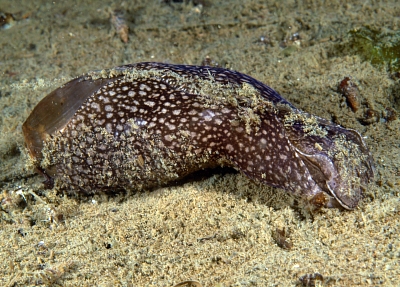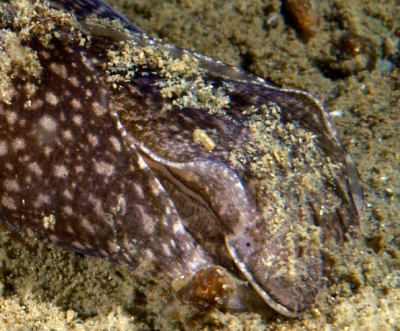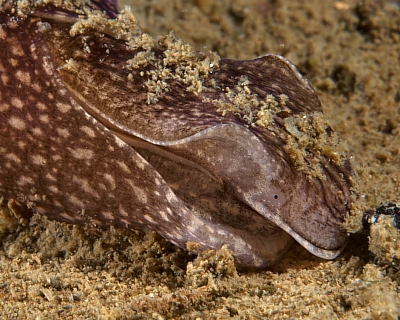Akera bullata from the French Mediterranean
June 20, 2007
From: Sylvie Grall


Concerning message #19999:
Dear Bill,
I'd like to include my contribution on Akera bullata and its ecology as we meet this species every year in the Etang de Thau in the Mediterranean when they come out of the mud to breed. It takes place in March/April depending on the conditions. They appear as adults (we never saw small individuals) and seem to feed on the bottom. There is for a very short time (it seems to last only a few days) when we see them swimming up without obvious reason. After this they disappear again and we can find empty shells around.
I am sending you a picture of Akera bullata seemingly feeding (or it may have been looking for tracks of its kin). It was moving the head on the sides while moving on.
Locality: Seawater lake, 8 m, France, Mediterranean, 14 april 2007, Muddy. Length: 8 cm. Photographer: Sylvie Grall.
It seems strange that it should feed on red algae, as it is spending most of its life in the mud. Or we may not have seen at the right time. I have also included a picture of a couple. The eggs look very much like those of Aplysia but in smaller amount of whitish "spaghetti".
Do you have precise information on the Hancock organs?
Thank you.
Sylvie.
sylvgrall@aol.com
Grall, S., 2007 (Jun 20) Akera bullata from the French Mediterranean. [Message in] Sea Slug Forum. Australian Museum, Sydney. Available from http://www.seaslugforum.net/find/20044
Dear Sylvie,
Thanks for the wonderful photos and information on this mysterious species. I guess the short period when it is seen is one of the reasons few people have studied it. Your description of it apparently arriving fully grown, breeding and then dying could be a description of what we know about many sea hares [see mass mortality page ]
Your mention of the Hancocks Organ reinforces the idea that many have had that Akera was actually a cephalaspidean 'bubble-shell' right up to Thompson in (1976). I remember discussing this with him but was unable to convince him that Akera was a proto-sea hare rather than a strange cephalaspidean. The Hancock's Organ is essentially a chemosdensoty organ found in cephalaspideans and consists of a sensory pad on each side of the head. I must make a point in preparing a page showing this organ. Umbraculum has a similar organ, also called a Hancock's Organ [see 3967], but its difficult to know if they are tthe same structure or not.
As I have said before, we don't know much about Akera, but one of the earliest studies (Guiart, 1901) is often ignored although it is extremely thorough and valuable. Guiart clearly realised the close relationship between Akera and the sea hares, In his anatomical account he describes a Hancock's Organ on each side of the head, in the groove between the head shiled and the foot. In your photo alongside it is the greyish brown band. It certainly is in the same place as in cephalaspideans and Guiart does describe some nerve branching to it, but I think we will need further work to see if it a chemosensory structure. Guiart calls the ear-like structures behind each eye as 'rudimentary rhinophores' and I would agree that they are the fore-runners of the sea hare rhinophore [see aplysiid head page]. In the aplysiids it is the rhinophores which have a chemosensory function, so it is possible there are chemosensory receptors on the ear-like flaps in Akera. If so, it would suggest the bands we are calling 'Hancocks Organs' in Akera are not these organs at all.
The other thing you can see in the close-up of the head is a whitish groove along the top of greyish band we are calling the Hancocks Organ. This is the sperm groove which carries the sperm from the female genital opening in the mantle cavity [which is back in the shell opening] forward to the penis which opens on the right side of the head. A similar groove can be seen in sea hares. I will talk more about mating in Akera in a separate message [#20050 ].
Concerning feeding, it is possible it does not normally feed on red macroalgae. I should have said in reponse to Helen Marshall's message [#19999] that there are a few exceptions to the red algae rule and they are Bursatella leachii and Stylocheilus striatus which feed on layers of 'blue-green algae' or cyanobacteria forming a layer of the sandy mud surfaces. This 'food' contains the chemicals needed to produce their red ink. Perhaps Akera also feeds on this layer. In my comments on Helen Marshall's message I said that Thompson & Seaward did not observe what Akera fed on, but I missed a couple of sentences where they say that in summer it fed on rafts of the green alga Enteromorpha and during the remainder of the year the brown gritty faeces suggested they fed directly on the sediment. [I have corrected my earlier comment].
-
Guiart, J. (1901) Contribution à l'étude des Gastéropodes opisthobranches et en particulier des céphalaspides. Mémoires de la Société Zoologique de France 14: 1-219, pls. 1-7.
Thanks so much for these interesting photos,
Best wishes,
Bill Rudman
Related messages
-
Looking for live Akera bullata
From: Jeffrey S. Prince, November 20, 2009 -
Re: Akera bullata swimming
From: Clare & Dick Donovan, April 21, 2008 -
Re: Akera bullata swimming
From: Barry Drinan, August 6, 2007 -
Re: Akera bullata swimming
From: Wellington Grey, July 5, 2007 -
Akera bullata from French Mediterranean [2]
From: Sylvie Grall, June 20, 2007 -
Akera bullata from Dorset, UK
From: Helen C Marshall, June 12, 2007 -
Re: Akera bullata swimming
From: Andrej Jaklin, July 20, 2006 -
Re: Akera bullata swimming
From: Ian Buzzard, July 18, 2006 -
Akera bullata swimming
From: Ian Buzzard, July 17, 2006
